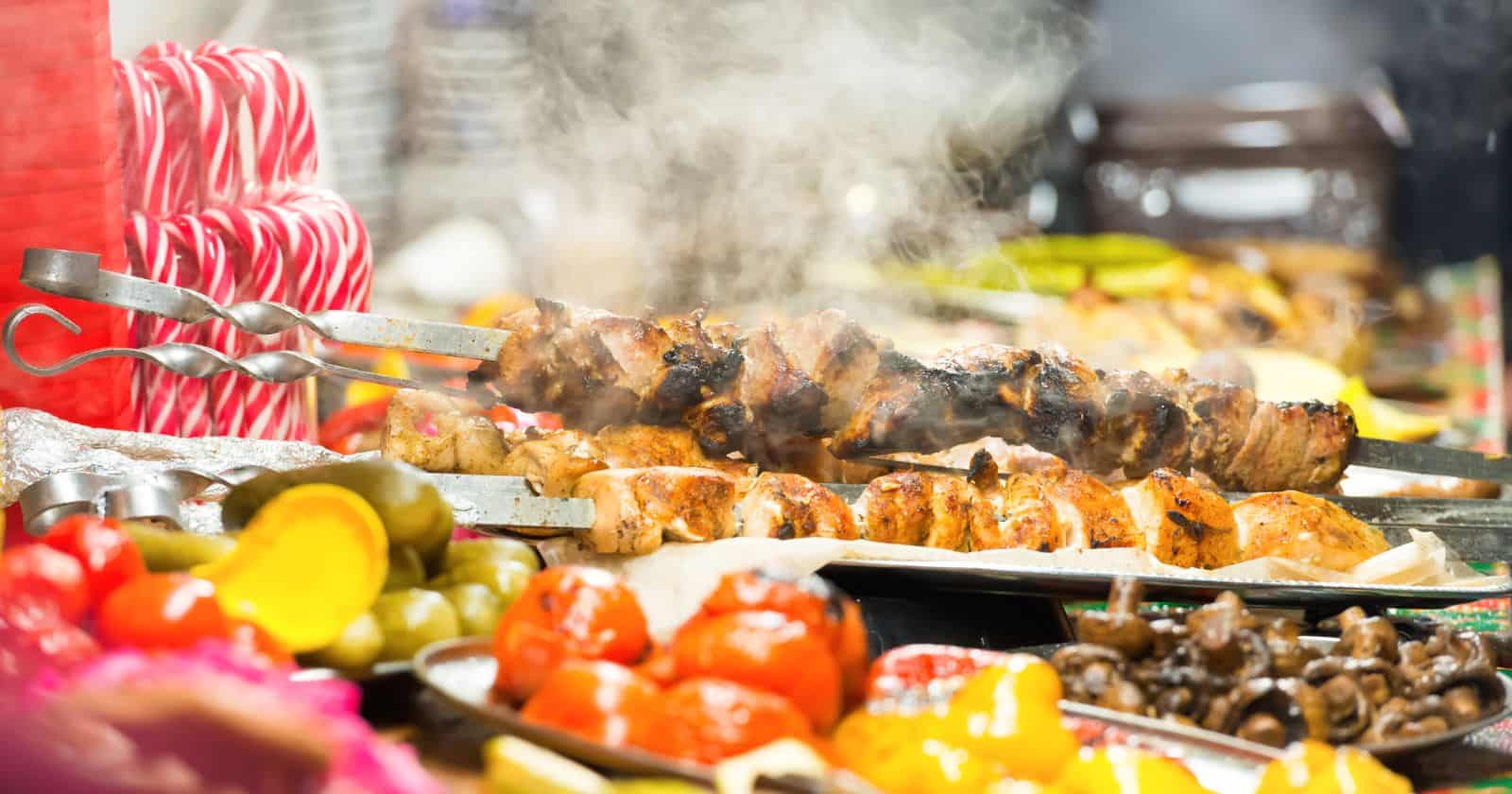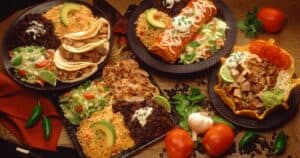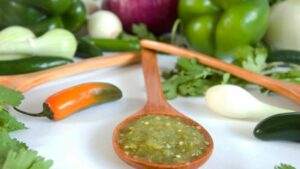Have you ever wondered how Mexican and Chinese cuisines stack up against each other? With flavorful tacos on one side and dim sum dumplings on the other, these are two of the most popular ethnic foods around. But they each have their own unique qualities when it comes to ingredients, cooking methods, taste profiles, and more.
In this in-depth guide, we’ll explore all the key differences between Mexican and Chinese food. You’ll discover how they vary when it comes to spices, main dishes, nutrition, and other factors. Let’s dive in!
Core Ingredients: The Building Blocks of Flavor
The base ingredients used in cooking provide the underlying flavors in any cuisine. Mexican and Chinese foods differ quite a bit in their core components.
Must-Have Mexican Ingredients
- Chili peppers – The many varieties of chilies, like jalapeño, serrano, and chipotle, bring the trademark Mexican heat and smokiness.
- Beans – Black beans, pinto beans, and refried beans add protein and hearty texture.
- Corn – In tortillas, tamales, or as-is, corn is an essential Mexican carb.
- Cheese – Queso fresco, queso añejo, and other Mexican cheeses bring creaminess.
- Avocados – These green fruits lend their signature creaminess to dishes like guacamole.
- Cilantro – The refreshing flavor of this herb brightens up salsas, tacos, soups, and more.
Chinese Food Must-Haves
- Soy sauce – This savory sauce made from fermented soybeans adds deep umami flavor.
- Rice – Steamed white rice accompanies many Chinese dishes.
- Noodles – Wheat or rice-based noodles are used in stir fries, soups, and more.
- Ginger – The zesty kick of ginger balances salty and sweet flavors.
- Garlic – Like ginger, garlic adds aromatic essence to stir fries and sauces.
- Vegetables – Chinese cooking highlights fresh veggies like bok choy, beans, and mushrooms.
While there’s some crossover, the core ingredients differ significantly between the two cuisines.
Cooking Techniques: Stir-Fry vs. Simmer
The types of cooking used also set Mexican and Chinese food apart. Each cuisine relies on its own go-to methods.
Mexican Cooking Techniques
- Simmering – Slow cooking beans, rice, stews, and more to meld flavors.
- Grilling – Meat and veggies are often chargrilled for smoky depth.
- Sautéing – Onions, peppers, and aromatics are sautéed to start dishes.
- Frying – Tacos, churros, and other goods get crispy through frying.
Chinese Cooking Techniques
- Stir-frying – Ingredients are quickly seared in oil to retain texture.
- Steaming – Dumplings, fish, veggies, and more are steamed to keep moisture.
- Deep-frying – A quick plunge in hot oil crisps up egg rolls, wontons, etc.
- Velveting – Pre-marinating tenderizes meat before stir-frying.
The hands-on pace of Chinese cooking stands apart from Mexican simmering.
Flavor Profiles: Spicy vs. Savory-Sweet
When it comes to overall taste, Mexican and Chinese cuisines each have their own distinct flavor personalities.
Mexican Flavor Notes
- Spicy – Chili peppers, salsa, and hot sauce bring the heat.
- Herbal – Cumin, oregano, cilantro lend freshness.
- Tangy – Squeezes of lime cut through rich flavors.
- Savory – Hearty meats, beans, and veggies taste satisfying.
Chinese Flavor Sensibilities
- Savory-sweet – Soy sauce, hoisin balance salty and sweet.
- Ginger-garlic – These aromatics permeate many dishes.
- Umami – Seafood, soy sauce, and mushrooms provide meaty umami.
- Numbing-spicy – Sichuan peppercorns create a numbing heat.
The bold spices of Mexican food differ from Chinese savory-sweetness.
Signature Dishes: Tacos or Dumplings?
With such different ingredients and flavors, the signature dishes of each cuisine vary greatly.
Beloved Mexican Dishes
- Tacos – Stuffed into soft corn or crispy fried tortillas.
- Enchiladas – Corn tortillas rolled up with sauce and fillings.
- Tamales – Masa dough stuffed with meats, cheese, or veggies.
- Quesadillas – Grilled tortillas filled with gooey melted cheese.
- Burritos – Large flour tortillas packed with rice, beans, meat, and more.
Famous Chinese Dishes
- Dumplings – Minced meat or veggie fillings steamed in delicate wrappers.
- Noodles – Lo mein, pad thai, dan dan, and other noodle-based fare.
- Stir fries – Quick veggie, meat, and sauce dishes served over rice.
- Soups – Hot and sour soup, egg drop soup, wonton soup.
- Dim sum – An assortment of small plates like dumplings.
The tacos and tamales of Mexico contrast with the dumplings and noodles of China.
Nutrition Profile: How They Compare
What about nutrition? Mexican and Chinese cuisines each have their own nutritional advantages.
Where Mexican Cuisine Shines
- Protein – Features leaner meats like chicken, turkey, beans, and fish.
- Fiber – Corn, beans, veggies, and whole grains provide filling fiber.
- Vitamins – Tomatoes, peppers, avocado, lime offer Vitamins A, C, and B6.
- Minerals – Good amounts of iron, potassium, and magnesium.
Nutritional Benefits of Chinese Food
- Less fat – Emphasizes steaming, boiling, and stir-frying with little oil.
- Veggies – Packed with antioxidant-rich vegetables and leafy greens.
- Whole grains – High amounts of brown rice, quinoa, and buckwheat.
- Omega-3s – Fish and seafood provide anti-inflammatory omega-3 fatty acids.
While both provide nutrients, Chinese food is generally lighter while Mexican offers more fiber.
Regional Variations Across Each Country
Mexican and Chinese cuisines vary greatly by region across each country. Here are some of the regional differences.
Regional Mexican Cuisines
- Oaxaca – Known for complex moles and grasshoppers (chapulines).
- Yucatan – Influenced by Mayan cuisine. Features achiote, habanero peppers, and citrus.
- Jalisco – Home of tequila and dishes like birria stew and carne asada.
- Veracruz – Specializes in seafood like fish tacos and ceviche.
- Puebla – Known for mole poblano and chiles en nogada.
Regional Chinese Cuisines
- Sichuan – Famous for bold, numbingly spicy flavors.
- Cantonese – Delicate, focused on fresh seafood like dim sum.
- Beijing – Known for Peking duck with thin, crispy roasted skin.
- Shanghai – Emphasizes seafood and braised meat dishes.
- Hunan – Features spicy, bold flavors and extensive use of rice.
The diversity across regions highlights local agriculture, customs, and history.
Celebratory Dishes for Special Occasions
From birthdays to weddings, Mexican and Chinese cuisines both have special dishes for celebrations.
Festive Mexican Dishes
- Mole – This complex, labor-intensive sauce is saved for big events.
- Cochinita pibil – Slow roasted pork marinated in citrus and annatto
spice . - Chiles en nogada – Stuffed poblano pepper topped with creamy walnut sauce.
- Carnitas – Tender pork simmered then crisped for tacos and sandwiches.
Chinese Celebration Foods
- Peking duck – This elaborate dish with thin, crispy skin is reserved for big occasions.
- Lobster – This prized seafood is a luxurious splurge.
- Buddha’s Delight – This elaborate mix of vegetables symbolizes prosperity.
- Niangao – These sticky rice cakes signify hopes for prosperity in the new year.
Special meals unite families and honor traditions in both cultures.
Street Food Scenes: On-the-Go Bites
Street food is an integral part of both cuisines. But the street eats differ in each country.
Mexican Street Foods
- Tacos – The quintessential Mexican street food, filled with various meats.
- Elote – Grilled corn on the cob slathered in savory sauces and cheese.
- Gorditas – Thick corn tortillas stuffed with meat, cheese, beans.
- Churros – Fried dough pastries coated in cinnamon and sugar.
- Fruits – Slices of mango, papaya, pineapple, and other fresh fruits.
Chinese Street Foods
- Jianbing – A savory crepe filled with egg, sausages, and cilantro.
- Soups – Quick, nourishing bowls of rice porridge congee, noodles, or broth.
- Baozi – Fluffy white buns filled with meat and vegetables.
- Skewers – Spicy seasoned chicken, beef, or mushroom skewers.
- Spring rolls – Crispy vegetables wrapped in thin pastry and fried.
Street food provides quick, satisfying bites in both cultures.
Fusion Food: Blending Traditions
Both cuisines have blended with others, creating popular fusion foods.
Mexican Fusion
- Tex-Mex – Texas-style Mexican food features beef, cheddar cheese, rice.
- Cal-Mex – Mexican recipes with fresh California ingredients like avocado.
- Korean tacos – Tacos filled with Korean barbecue meat.
- Chinese burritos – Large tortillas stuffed with Chinese fillings.
Chinese Fusion
- Chinese-American – Adaptations like beef with broccoli, egg foo young.
- Japanese ramen – Ramen noodles in savory Chinese broth.
- Kung pao pastas – Spicy Sichuan sauce tossed with pasta.
- Thai fried rice – Chinese rice stir-fried with Thai basil, chilies, and fish sauce.
Blending cuisines creates inventive combinations loved by foodies worldwide.
Satisfying Your Cravings
As you can see, Mexican and Chinese cuisines differ greatly when it comes to core ingredients, cooking methods, flavor profiles, dishes, and more. Both offer incredibly diverse and crave-worthy food options rooted in tradition.
The next time you’re looking to satisfy a craving, consider trying an authentic Mexican mole dish or juicy Chinese dumplings. With a world of flavors to experience, why limit yourself to just one cuisine? Expand your palate and enjoy the best of both worlds.





